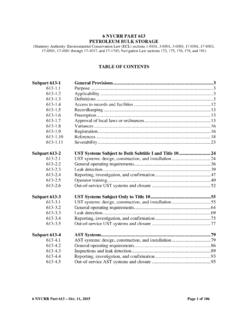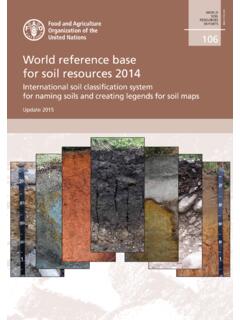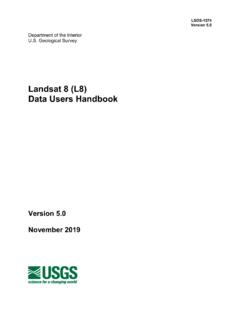Transcription of US Topo Map Symbols - EDRnet
1 US Department of the InteriorUS Geological SurveyUS Topo Map SymbolsWhat is a US Topo map?A US Topo map is a digital topographic map that covers of longitude by of latitude and is produced at a scale of 1:24,000. US Topo maps are freely distributable and are available for download on the Web from the USGS Store ( ) in Portable Document Format (PDF) with geospatial extensions (GeoPDF , a registered trademark of TerraGo Technologies). PDF maps can be viewed and printed with any conforming PDF software. Versions and of Adobe Reader and Acrobat software provide access to the geospatial functionality of the US Topo map.
2 Adobe Reader is available for free at Geospa-tial functionality is enhanced with the TerraGo Toolbar , a plug-in to the Adobe software that may be downloaded for free at More information about US Topo maps and their use is available at base data layer of a US Topo map is a recent orthographic aerial photograph. These orthoimages have been corrected to remove scale distortions that result from the varying terrain and deviations of the aircraft s position from the true vertical. The maps include contours that show the shape of the Earth s surface, hydrographic features such as lakes and rivers, roads, boundaries, and geograph-ic names.
3 Additional data from the geographic data themes of transportation, names, elevation, hydrography, boundaries, structures (such as fire stations) and land cover (such as woodland tint) is being added to the maps as they are updated, resulting in a product that will become progressively more robust over time. Feature data is incorporated from national Geographic Information system (GIS) databases under the stewardship of USGS data programs. The US Topo map is intended for conventional map users, not for advanced GIS analysis. However, most of the data sources used are in the public domain and may be downloaded for free from The National Map (TNM) ( ).
4 US Topo maps are revised on a three-year production on US Topo MapsThe underlying orthoimage for each US Topo map shows those features on the Earth s surface that are visible to the eye. Because each map is made at a scale of 1:24,000 (one inch on the map represents 24,000 inches or 2,000 feet on the ground), selected features are also shown and emphasized by Symbols , geographic names, and highway route features may be represented as points, lines, or polygons. They incorporate different colors and patterns to distinguish between feature types and to show each feature s importance.
5 For example, a perennial stream is symbolized by a solid blue line while an intermittent stream is shown by a blue dashed and dotted line. A large reservoir is depicted by a polygon while a small reservoir may be shown by a point symbol if it is too small to show as a Symbols of different shapes and sizes depict features such as structures, dams, gates, rocks, waterfalls, and wells. Linear map Symbols (lines) show such features as roads, rivers, boundaries, and contours. Color is used to show the class of information: topo-graphic contours in brown, streams and rivers and other hydrographic features in blue, and roads in black and red.
6 Areal features are outlined to depict the areal extent and may also be emphasized by a color tint. Names and labels are shown in different type fonts, sizes, and unique feature of a topographic map is the contour. These lines do not exist on the Earth s surface. They join points of equal eleva-tion above a zero level surface (such as Mean Sea Level) and therefore show heights of the land and reveal the shape of the land surface. Heavier brown lines are index contours and are labeled with the elevation they represent. Closely spaced contours indicate a steep land slope; widely spaced contours show more level ground.
7 The elevation difference between adjacent contours is the contour interval. A map of a relatively flat area may have a contour interval of 10 feet. In steep areas an interval of 100 feet or more may be used to avoid coalescence or convergence of the contour lines. The contour interval is always noted below the bar scale in the map cartographic representation of roads has been updated from a characterization based on organizational maintenance (Interstates, US routes, State routes, etc.) to a functional classification defined as follows: Expressway1: A controlled access, divided arterial highway for through traffic.
8 Secondary Highway1: Hard surface highways including secondary State routes, primary county routes, and other highways that connect principal cities and towns, and link these places with the primary highway system . Local Connector1: Hard surface roads not included in a higher class and improved, loose surface roads passable in all kinds of weather. These roads are adjuncts to the primary and secondary highway system and represent major arteries through populated places. Local Road1: Roads used primarily for local Federal Highway Administration Planning Glossary - Chamber/SpillwayRock XSpringE'WaterfallWell Canal/DitchEarthen DamNonearthen DamLeveeRapidsHYDROGRAPHY Underground #"!
9 Fire StationFHospitalHSchoolPost Office nPrison Police State CapitolOil/Gas Pipeline* ^ |||TRANSPORTATIONA irport RunwayRailroadRoad Features 25 [830 470 TunnelFerry4 WDLocal RoadLocal ConnectorRampSecondary HwyExpresswayRoad ShieldsInterstate RouteUS RouteState RouteForest Service Primary RouteForest Service Secondary RouteForest Service High Clearance Route 240420 PLSS Township/Range Township/Range (protracted)Section Section (protracted)Area of Complex ChannelsInundation Area)~)~~~~)~)~~~~~)~)~~~~~~)~)~~~~)~)~) ~~~~~~))~~~FlumeAirport FeaturesRailroad FeaturesDamGate|Gaging StationIce MassTrail|OOOOOOOOOOOOOOOOOOOOOOOOOOOOOO OOOOOOOOOOOOOOOOOOOOO qqqqqqqqqqqqqqqqqqqqqqqqqqqqqqqqqqqqqqqq qqqqqqqqqqqqqqqqqqqqqqqqqqqqqqqqqqqqqqqq qqqqqqqqqqqqqqqqqqqqqqqqqqqqqqqqqqqqqqqq qqqqqqqqqqqqqqqqqqqqqqqqqqqqqqqqqqqqqqqq qqqqqqqqqqqqqqqT 34 N R 79 W1 363636 Swimming Pool (Intermittent LakePerennial LakePipelinePlayaSettling PondTailings Pond=Reservoir Intermittent StreamPerennial StreamSubmerged StreamNonearthen ReservoirWashTunnelT 34 N R 79 W1 363636 POLand GrantsLAND]
10 ReliefTERRAIN IMAGESO rthoimageContour FeaturesIndexIntermediateSupplementalDep ression IndexDepression IntermediateDepression Supplemental40004000 HYDROGRAPHY continuedBOUNDARIESI nternationalState or TerritoryCounty or EquivalentForest ServiceShaded ReliefJurisdictional BoundariesFederal Administered LandsNational Park ServiceDepartment of DefenseBureau of land Management* Fish and Wildlife Service AIANNH Area**Currently on Alaska US Topo maps onlyABBREVATIONSNote: Symbols use transparent color. When these Symbols overlap the colors blend. This alters their appearance from how they are represented in the map legend.







